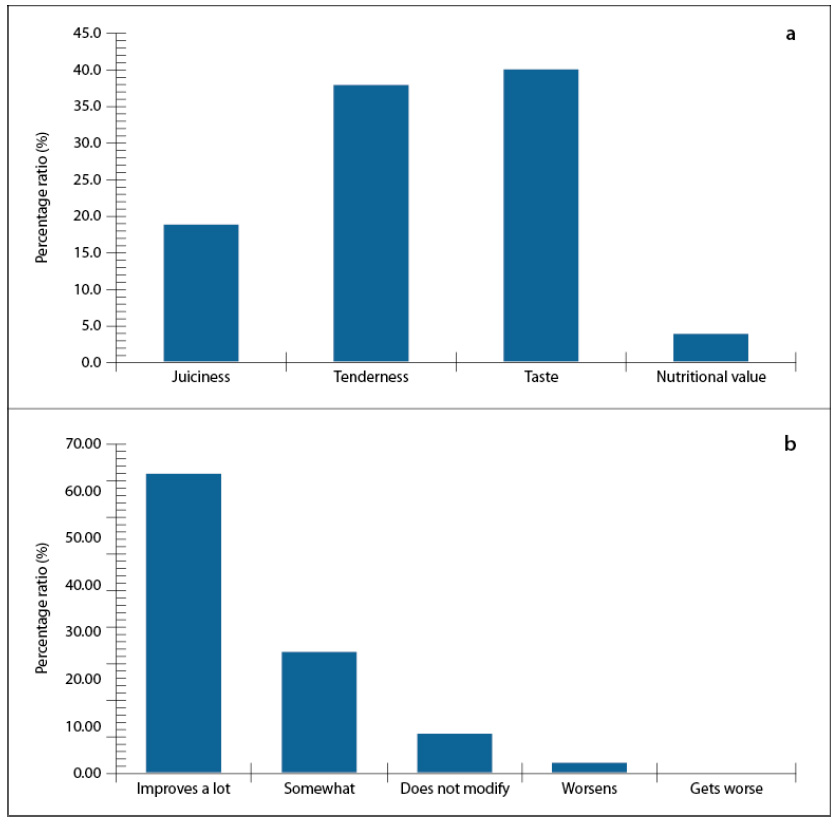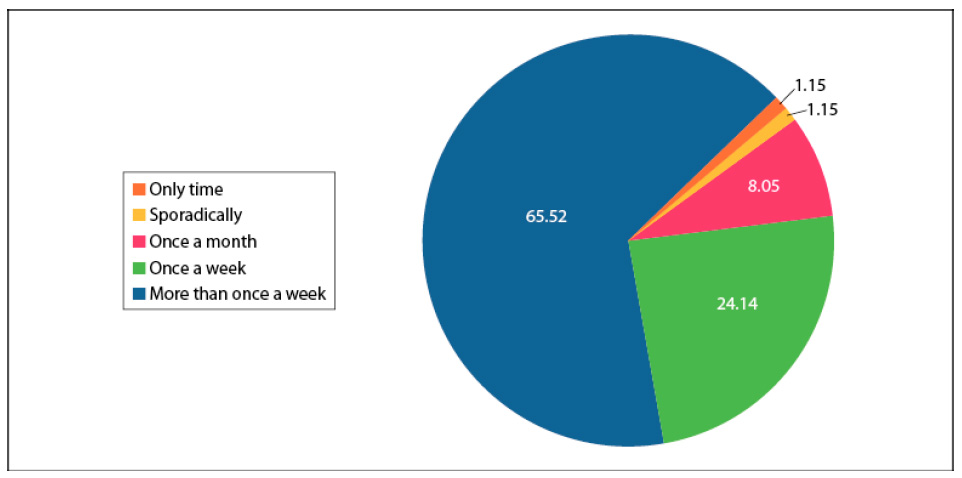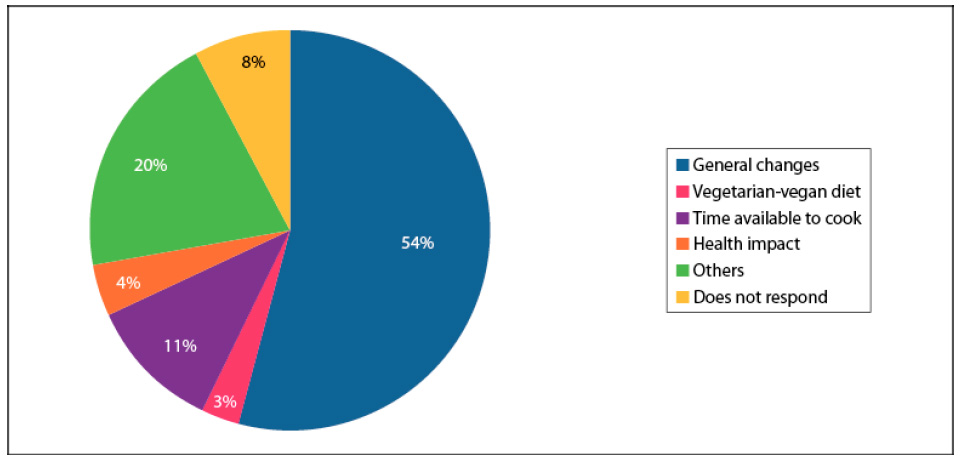Introduction
In Argentina, especially in inland cities, beef consumers have been observed to choose neighborhood businesses and butcher stores, preferably, to purchase this food (Bifaretti, 2007; Cáffaro Tommasiello et al., 2018). On the other hand, Urquiza (2018) observed that consumers are willing to pay price differences in butcher shops that give them confidence, provide product quality, and guarantee hygienic-sanitary safety.
The beef production chain in Argentina, from animal production to purchase by the consumer, has various links and actors involved: producer, cold storage, distributor, dealer/seller (butchers), and, finally, the consumer. In addition, today, it is known that each of the members of this agro-food chain must fulfill its function to achieve and maintain good product quality. Currently, the data on aspects such as beef production and the number of slaughtered animals are surveyed, periodically updated, and made public by the regulatory entity that is Servicio Nacional de Sanidad y Calidad Alimentaria [National Service of Health and Food Quality] (Senasa, Argentina; http://www.senasa.gob.ar/). Likewise, aspects regarding beef consumption, quality, quantity, and the valuation of the national product have also been studied and are updated by Instituto de Promoción de Carne Vacuna Argentina [Institute for the Promotion of Argentine Beef] (IPCVA; http://www.ipcva.com.ar). Moreover, different scientific areas (economic, social, production, and food, among others) have addressed different studies on the consumption and beef quality aspects in Argentine consumers (Cáffaro Tommasiello et al., 2018; Faverin & Machado, 2019; Urquiza, 2018).
However, traits related to the handling, assessment, consumption, and quality attributes of Argentine beef have not yet been reported, according to the observation of the sellers of this product in neighborhood butcher shops.
Being this a key link in the chain given that it involves imparted features that range from unloading the beef, stripping and selling the cut meat that is offered to the consumer, the aim of this work was to investigate the aspects related to production, handling, assessment, consumption and quality attributes of beef in neighborhood retail stores, through surveys to butchers.
Materials and methods
The unit of observation was the slaughter shop. In each, data was collected by interviewing the butchers. The following activities were proposed to achieve the proposed aim:
Establish the total number and distribution, according to the areas of residence (neighborhood groups), of retail stores that sell beef and authorized butchers in the city of Tandil, Buenos Aires, Argentina. Determine the distribution frequency and sample number of representative butcher shops per zone.
Inquire, through a survey of the beef sellers, both aspects and knowledge related to beef production and handling, and the beef quality they offer, as well as the storage/maturation features in sale points. Also, examine quality attributes and ratings of this product by their customers.
The surveys were carried out in the city of Tandil, Buenos Aires, during the July-December 2018 period. The sale points were chosen randomly, and the survey considered the willingness and confidentiality of the data of the seller. The survey addressed a total of 42 questions in which the following aspects were addressed:
The seller (level of education, age, and years of profession, among others);
The knowledge of the seller about the production and slaughter characteristics of the product offered;
The management, handling, and storage characteristics of the merchandise at the point of sale, and aspects related to the consumption and quality attributes of the beef that their clients value (features of the quality demanded).
In the city of Tandil, different neighborhoods are recognized (figure 1a), and these can be grouped into seven areas according to the municipal geographic distribution. From the initial survey, a total of 157 authorized beef retail stores were eligible. Conversely, from the information obtained, the minimum number of butcher shops to be evaluated was statistically estimated according to the size and number of butcher shops by area. The result finally indicated that a total number of 60 butcher shops should be surveyed distributed in the seven areas considered. The number of butcher shops to be evaluated by zone considered the relative frequency distribution for each zone (figure 1b), and the sample size with a confidence of 95 %, a proportion of 50 %, and an absolute error of 10 %.

Source: a) Courtesy of the municipality; b) Elaborated by the authors
Figure 1 a) Territorial map of the city of Tandil (Tandil, Buenos Aires Province, Argentina: - 37.051549, -59.312838); b) Distribution of butcher shops by neighborhood in the city of Tandil. Relative frequency (Nzonei/NTotal) *100 (%)
Once all the information was collected, a descriptive analysis was carried out. A cluster analysis was performed to observe possible groupings or similar behaviors between the areas, taking each neighborhood as a classification variable (figure 2a).
Subsequently, to establish the most relevant cluster formation variables, a Biplot correspondence analysis was performed (figure 2b). The variables that showed significant differences between groups, according to the correspondence analysis, were taken for subsequent analysis. The comparison of the proportions for these questions was carried out using a generalized linear model, considering the binomial distribution of the response variable (yes-no) and using the clusters obtained as a classification factor. The other variables, which did not show significant differences between groups, were evaluated descriptively (considering the total number of respondents).
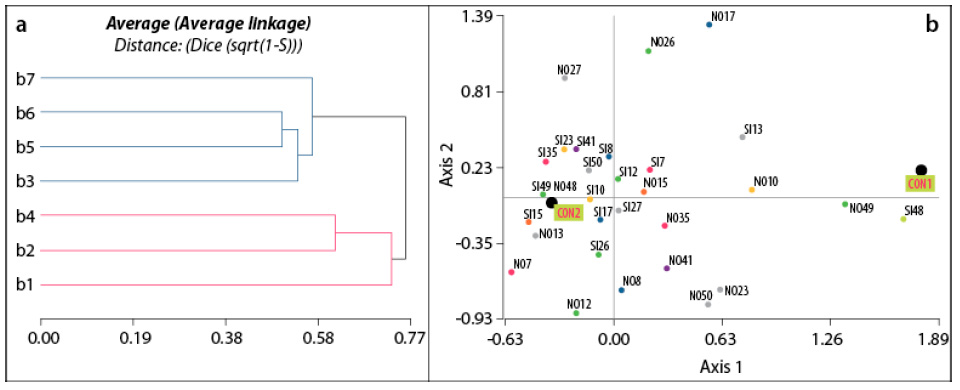
Source: Elaborated by the authors
Figure 2 a) Cluster analysis, dendrogram results; b) Biplot results for each of the dichotomous questions according to the two clusters; CON1-Zones 1, 2, 4, and CON2-Zones 3, 5, 6, and 7
Finally, for the statistical analysis of the data, the R Core Team (2018) software was used.
Results and discussion
Geographical and local distribution aspects
The cluster analysis allowed observing the difference between the zones (figure 2a-dendrogram). The result indicated two groupings, CON-1(3-zones) with zones 1, 2, and 4, and CON-2(4-zones) with zones 3, 5, 6, and 7. Besides, this reflected in CON-1, three zones close to each other and far from the urban center; meanwhile, CON-2 grouped all downtown areas, and others comprised by recently formed neighborhoods. Although the current study did not address aspects related to economic variables and quality of life, the groupings of the areas (clusters) obtained responded in a similar way to the observations highlighted by Velázquez (2019), a researcher of Instituto de Geografía Historia y Ciencias Sociales [Institute of Geography, History and Social Sciences] (IGEHCS, Conicet-Unicen).
The study of Velázquez (2019) addressed the social aspects of the city of Tandil. In this study, the author observed that the areas are distributed according to urban development and growth and that the central radius of the city refers to the areas with a better quality of life, while certain areas further away from the central radius are neighborhoods with a lower quality of life. This study also addressed socio- economic, educational, health, housing, and environmental variables not evaluated in the current study.
General information about meat shops and retailers
In Argentina, at least five stages can be highlighted within the beef production process: breeding, fattening, slaughter, stripping, and retail sale. In relation to the last stage, i.e., retail, butcher shops, and supermarkets, are included. Butcher shops buy mostly the half cattle carcasses and carry out deboning and direct sale of the cuts to the consumer. Nonetheless, Cáffaro Tommasiello et al. (2018) observed in their results that Argentine meat consumers from Buenos Aires preferentially purchase meat cuts in neighborhood butcher shops.
From the general data survey, gender, nationality, age, level of training, and years in the merchant profession were recorded. It was observed that all the sellers in the sixty butcher shops surveyed were male and of Argentine nationality. The age of the sellers and the percentage distribution observed showed that the age ranges were < 21 years and > 60 years, representing a minority (only 1.75 % and 3.51 %, respectively), while the age ranges 21-30, 31-40, 41-50, and 51-60 years, represent the majority (12.28 %, 28.07 %, 33.33 %, and 21.05 %, respectively). Regarding the study level, 25 % of the respondents completed only their primary studies; 10.71 % just started but did not finish the secondary level; 44.64 % finished secondary education; 12.50 % have incomplete tertiary/university studies, and only 7.14 % indicated having a complete tertiary/university education.
Concerning the years in the profession, the results indicated that 8.33 % correspond to butchers with less than 5 years in the profession; 16.67 % have from 5 to 10 years in the profession; the group between 11 and 25 years in the profession included the majority of the respondents with 46.67 %, and 28.33 % had more than 25 years in the profession. The data collected in the current study is novel, given that descriptive reports on this profession have currently not been registered.
Beef production, slaughter, and quality aspects and characteristics
Different productive factors such as breed, diet, age, weight at slaughter, as well as variables before and after slaughter, among others, affect the traits related to the amount of fat or the beef quality (Guerrero et al., 2013). The butchers were consulted, on the one hand, about the type or types of cattle offered in their premises; the possible selection options were: steer, young steer, heifer, veal, and cow, a classification considering the Fat Type-Degree, according to Oficina Nacional de Control Comercial Agropecuario [National Office of Agricultural Commercial Control] (ONCCA, 2005). The responses did not show differences between clusters and indicated that currently, in the Buenos Aires retail market, steers (39.74 %) and young steers (30.77 %) are sold and consumed, followed by veals and heifers (17.95 % and 11.54 %, respectively). Likewise, of the total number of butchers surveyed, none indicated that they sold cow meat.
Conversely, it was then consulted whether in the last 5 years there was variation in the beef cattle breed; in response to this question, the sellers of both clusters indicated an absence of changes in this last period. Continuing with the questions related to production, the type of feed received by the bovines was consulted. Without differences between clusters, 25 % do not know the feed that the animal receives, 5 % indicated that they sell animals that are maintained 100 % under pasture; 15 % stated that the feeding was employing the Feedlot system, and 55 % stated that the animals were fed with pasture and finished with corral feeding.
In relation to the interest of consumers, the results of Cáffaro Tommasiello et al. (2018) observed that Argentine consumers are mostly indifferent to the production system of the beef consumed. The study carried out by Enciso and Burkart (2017), from the International Center for Tropical Agriculture (CIAT), showed that consumers, in order of importance, when buying beef and considering the type of cut, left last on the scale of importance the factors seal of quality, environmentally friendly production, and animal management.
Regarding aspects related to slaughter and quality traits of the cattle assessed, no differences were observed between clusters. The responses on the total number of respondents indicated that 85 % could choose the beef they want to unload. In addition, 86.67 % indicated knowing the slaughter day corresponding to each cow. An interesting aspect about these traits was the question ¿do you buy beef on any particular day of the week? In the responses, significant differences could be observed between the clusters (p = 0.00685), finding that in CON-1, 80 % of the butchers indicated that they acquired the beef on a specific day of the week (being mainly Tuesday), unlike what was found in CON-2, where 71% of the butchers stated that they do not receive the beef on a specific day of the week, being random or based on sale-demand. These differences could be due to the sale volume of the different stores and their relationship concerning the geographical location. It is worth mentioning that the areas grouped in CON-2 consistently became the most central areas of the city, while those grouped in CON-1 correspond to more remote areas. This could be because the CON-2 zones show a higher demand-sale volume and, therefore, require a higher beef replacement. Conversely, no butcher reported finding differences in the cattle according to the day of unloading.
When inquiring about the possibility of cold storage and related quality aspects, all dealers indicated having a cold storage room. Furthermore, of the total of those surveyed, 75 % store a maximum of two days; 18.33 % store three days, and only 6.67 % store one day (≤ 24 h). On the other hand, regarding the observation of changes in traits impacted by storage, 41.67 % stated that they did not observe changes in the quality of the product, an equivalent percentage of 41.67 % indicated that they observed deterioration-decay after storage in a cold chamber, and only 16.67 % mentioned that they observed post-storage improvements. These results reflect ignorance about the ripening process or lack of chambers with adequate temperature (4-5 °C) and relative humidity (60-75 %) controls. Also, this could be due to cultural factors (tastes), habits, and customs. Equivalent results were reported by Cáffaro Tommasiello et al. (2018), who observed ignorance by Argentine meat consumers about the concept of beef maturation and improvements in tenderness. The authors also observed that consumers do not contemplate the possibility of buying beef with more than 15 days of slaughter.
From the total number of responses given by dealers on the presence of fat in beef cuts on the quality, juiciness, tenderness, flavor, and nutritional value attributes, the following contributions on the attributes were found to be important: juiciness and tenderness (figure 3a). Likewise, when asked about the impact of fat color on beef quality (figure 3b), it was interesting that 63.33 % of all butchers considered that color significantly improves beef quality (it is worth mentioning that information on the fat color that provides this improvement was not consulted).
Beef quality, consumption, and assessment aspects, according to the appreciation of the seller
An important aspect was to know the sale percentage of each of the three main meat types offered (sheep, pork, and poultry). The results considering the total number of respondents show that 69.75 % of the sales correspond to beef, 18.20 % to pork, and only 10.75 %, to poultry. The percentage distribution of the type of meat sold was similar between CON-1 and CON-2, but significant differences (p = 0.048) were observed between the clusters concerning its distribution in the last 5 years. For CON-1, the percentage of meat types sold (beef, pork, and poultry) is constant in the last 5 years; however, CON-2 stated that the distribution had not been the same over the last 5 years. The distribution of the meat types sold resulted in slight differences with the data recovered in the study on Argentine consumers by Cáffaro Tommasiello et al. (2018). The current study, like other Latin American studies (Schnettler Morales et al., 2006; Schnettler et al., 2008), reflect that the most consumed meat type is bovine, followed by poultry and pork. The differences observed with respect to the changes in consumer habits in the last 5 years could be due to cultural and economic changes.
In figure 4, the visit frequency of clients to the shop can be observed, considering all the responses. The results showed that the majority of the customers visit the store more than once a week.
In relation to the quality assessment vs. price aspects, all dealers indicated that quality is the valuation aspect that customers highlight the most.
Butchers were consulted, which are the six most chosen cuts. Considering all the cuts mentioned and the total number of responses, figure 5 shows the percentage distribution of the most chosen meat cuts. Results show that topside/inside, minced meat, plat 10 ribs, knuckle, shoulder clod, and flor ribs are the most chosen cuts; on the contrary, the least chosen were leg of beef heel muscle off, and chuck. For their part, rose m. cutaneous trunci and eye round also showed a low purchase frequency.
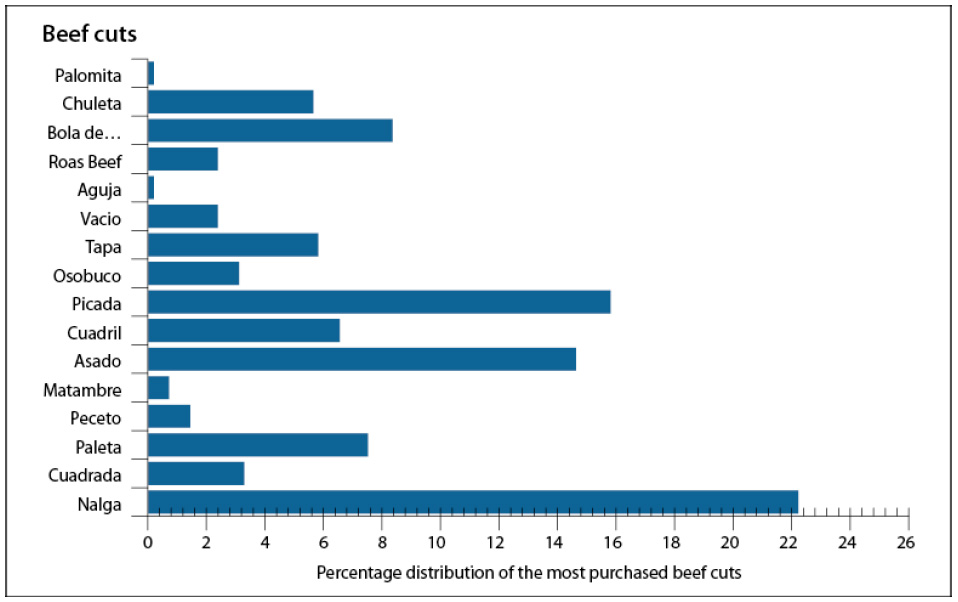
Source: Elaborated by the authors
Figure 5 Percentage distribution of the most chosen meat cutsNalga (topside/inside), cuadrada (flat), paleta (shoulder clod), peceto (eye round), matambre (rose m. cutaneous trunci), asado (plat 10 ribs), cuadril (rump cap), osobuco (shin-shank bone in), tapa (topside/inside cap), vacío (flank), aguja (chuck), roast beef, bola de lomo (knuckle), chuleta o bife (flor ribs), palomita (leg of beef heel muscle off), and picada (minced meat)
Butchers were also asked if, in the absence of a cut requested by the client, they offer an available cut. Ninety-eight percent of the butchers indicated offering an available cut. On the other hand, their observation regarding the purchase of different cuts according to gender (female and male), the butchers of both clusters indicated that they did not observe differences in the type of cuts purchased according to gender.
Furthermore, butchers were asked if they consider that the person who makes the purchase is the one who will cook it later. All butchers consider that whoever buys the beef cut is the one who will then be in charge of cooking it (figure 6). These data are novel since equivalent studies on these aspects have not been found.

Source: Elaborated by the authors
Figure 6 Appreciation of the seller when asked ¿do you consider that the person who buys the beef cut is the same person who will be in charge of cooking it? Percentage distribution of total responses (n = 60)
Additionally, the predominance of specific cuts according to the season of the year was consulted. All butchers surveyed (100 %) indicated that they observed differences between cuts sold in summer vs. winter. Thus, from the total number of responses, it could be observed that in summer, cuts for roasting and barbecue predominate, such as plat 10 ribs, topside/inside cap, flank, and flor ribs. The sale of hamburgers was also mentioned by several butchers, while, in winter, the most prevalent cuts for sale are those chosen for stews, casseroles or to be cooked in the oven, the majority of which are beef pulp, including the cuts of the front quarter and osso buco or arm. Some butchers mentioned that cuts for Milanese or pre-made Milanese (oven cooking or frying) are more chosen in winter than in summer. These results agree with those of Cáffaro Tommasiello et al. (2018) in consumers, inferring a relationship of the frequency of consumption of specific cuts and cooking methods observed in this study. Moreover, Cáffaro Tommasiello et al. (2018) observed that Argentine beef consumers vary the cooking methods: oven in winter, and grill or charcoal in summer. They also observed that boil cooking is low in both periods and that frying as a beef cooking method turned out to be low or null.
On the other hand, butchers were asked whether they made or proposed "special offer cuts" as a sales strategy. To this question, only 14 of 60 agreed to answer. Of the 14 responses, 50 % do so as a possibility to increase their sales, 42.87 % use it to sell a surplus, and 7.13 % indicated the option to try a new product.
Regarding beef quality aspects and attributes, sellers were consulted about the aspects that the clients highlight the most. They indicated that when buying, customers prioritize sanitary-hygiene, quality, and trust attributes, as well as knowing the use of good agricultural practices for animal development.
Faced with the question about how their buyers determine or consider that a cut is fresh, of the total number of respondents, 84.62 % indicated that for their customers, the color is what determines the freshness of the product, and 12.31 % consider that the product is fresh if the cutting (deboning) is done when purchased. For their part, 3.08 % did not respond, and none of the butchers indicated that the day of the week affected the freshness attribute for consumers.
Conversely, there are cultural and valuation differences on the relationship between the fat content and traits present in the beef cuts for consumers. For this reason, butchers were consulted about the preference of their customers regarding the presence/absence of intramuscular fat. The results indicated significant differences between CON-1 and CON-2 (p < 0.0001), noting that in CON-1, 80 % of the butchers indicated that their clients prefer cuts with intramuscular fat content. On the contrary, in CON-2, 96 % of the butchers indicated that their clients prefer beef with an absence of intramuscular fat.
It is known what differences the valuation of intramuscular fat between cultures and changes in habits in modern society. For this reason, the butchers were asked if these preferences had changed today compared to 10 years ago. Again, differences were observed between the clusters: CON-1 respondents stated that they did not observe changes, while CON-2 did observe them (p = 0.0006). Preferences for the presence-absence of intramuscular fat vs. lean cuts could be due to socioeconomic differences and access to information.
Currently, health agencies (Hospital Italiano, Argentina https://www.hospitalitaliano.org.ar/#!/home/isalud/noticia/5911) have published and promote the consumption of lean cuts on their websites. This information does not reach all sectors equally, being able to infer access to information in the purchase decision. Additionally, differences in the assessment of fat content and quality, along with the cholesterol content over the years, were observed in the report published by Recalde and Barraud (2002).
Regarding consumer purchase frequency (p > 0.05 between clusters), 81.05 % of the total number of butchers stated that they observed a decrease in recent years. To know the causes of this decrease, they were consulted, which did they consider to be the main causes. As can be seen in figure 7, the main causes are the general change in consumption (including general socio-economic aspects), the time available for cooking, and aspects related to health. No strong relevance was observed in relation to religious beliefs or type of diets (vegan/vegetarian).
Conclusions
From the results of the survey of butchers in the city of Tandil, Buenos Aires, Argentina, it was observed that neighborhood beef sellers have knowledge about animal management corresponding to the beef they sell, both on aspects related to animal feeding as well as to slaughter management. Regarding the valuation attributes of beef, it was observed that to date, butchers do not consider the beef maturation process, but they expressed full knowledge of the quality aspects of beef sought and valued by their customers.
The responses were grouped into two clusters (zones), presenting significant differences only between clusters in the beef purchase frequency and the assessment of the presence of intramuscular fat by their clients. These differences could respond to socio-economic and demographic factors as a whole. This reflects the need to continue deepening the research on meat quality and consumption with interdisciplinary work. Likewise, the results are novel, but the need for future multidisciplinary research is manifested to achieve improvements and contributions for the beef production and sale, and the consumer, considering productive, socio-economic, technology, and meat science aspects.











 text in
text in 


